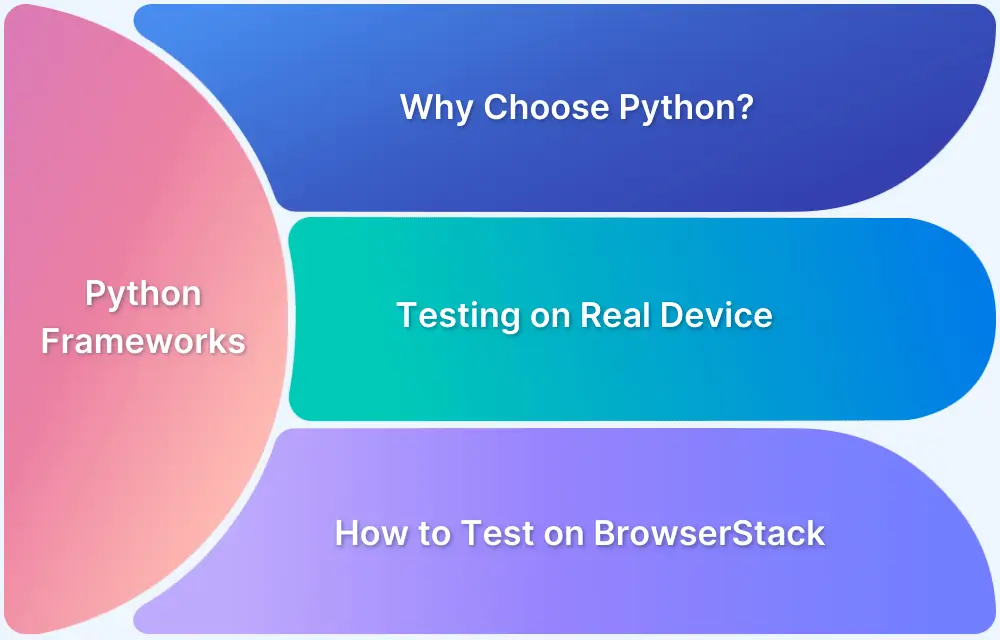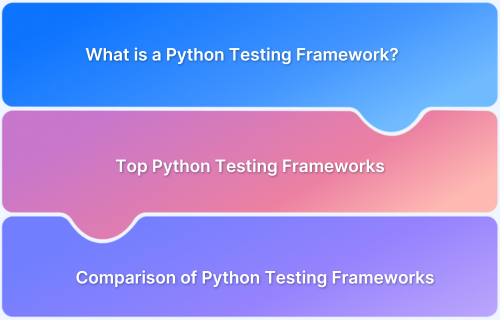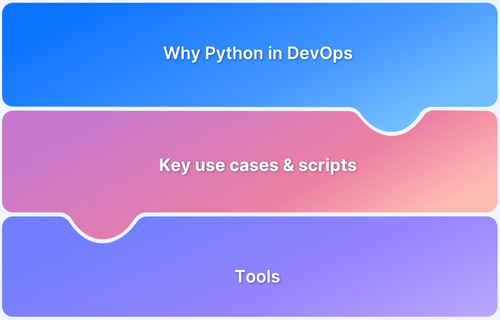Do you find yourself grappling with routing complexities, securing endpoints, and managing scalability while building a REST API? These hurdles can slow down development and introduce errors, making it difficult to deliver performant, secure APIs on time.
This is where frameworks come into play, offering pre-built solutions that save time, improve efficiency, and reduce the risk of errors. With the right framework, you can streamline development, focus on business logic, and ensure your API is both secure and scalable.
Whether you’re looking for simplicity, flexibility, or performance, Python offers a range of REST API frameworks, each catering to different use cases and team workflows.
However, with so many Python frameworks available, it can be challenging to determine which one best suits your project’s specific needs.
What is Python Rest API Framework
A Python REST API framework is a software library or toolkit that provides developers with tools and functionalities to build RESTful APIs (Application Programming Interfaces) using the Python programming language. REST (Representational State Transfer) is an architectural style that allows systems to communicate over the web using standard HTTP methods, such as GET, POST, PUT, and DELETE.
A Python REST API framework simplifies the process of building RESTful APIs by providing abstractions, utilities, and pre-defined patterns that handle common tasks, such as routing requests, parsing and validating input data, serializing and deserializing data, handling authentication and authorization, and more. It helps developers focus on defining the business logic of their APIs rather than dealing with low-level HTTP handling.
Read More: Top 8 Python Testing Frameworks in 2024
Understanding the Capabilities of REST API and REST Principles
REST API can be used in any programming language and it also supports various data formats. Here’s the principles of REST:
- Uniform Interface: A uniform interface is a way in which the client communicates with the server independent of the device or application. It indicates that the server transfers information in a standard format. This format can be different from the internal representation of the resource on the server application. The API need to have some specific URI(Uniform Resource Identifier) for each resource, such as /students/{roll_number}.
- Decoupling client-server: The client and server must be completely independent of each other. The only information that the client knows should be the URI. It should not interact with the server in any other way. The request whichever is sent from the client can either be approved or rejected by the server. Also, the server application should pass on the data to the client without any modification.
- Layered system: Since the client and server applications are decoupled, the call and the response can go through different layers. REST APIs are designed for preserving privacy, so neither client nor the server identifies the source of communication.
- Statelessness: Statelessness means that the calls can be made independently of one another. Each call contains all the data which is needed to complete the request. In other words, REST APIs do not require servers to store any data (server-side sessions) related to a client request.
- Cache: REST API supports caching, it is for storing responses on the client or an intermediary to improve server response time. For example, when you visit a website and you visit a different web page of that particular website, the same image may be needed to be sent again. To avoid this, the caching feature is included. This reduces the load on the server.
- Code on demand: In REST architecture, servers can help clients with functionality by transferring software programming code to the client. For example, when you fill in a form on any website, the webpage or browser may point out the mistake we make such as an improper phone number.
Benefits of REST API
RESTful API includes the following benefits:
- Scalability: Statelessness makes REST API to be scalable as it optimizes client-server interaction. As the server need not remember the past request information, it removes the server load. Since it maintains good cache memory, this reduces client-server interaction.
- Flexibility: The decoupling nature of client-server makes REST API more flexible. The platform or technology changes in the server don’t affect the client application. It also has a layer application function which adds more flexibility. It should be noted that the developers can change in database layer without rewriting the application logic.
- Liberation: REST API is independent of technology. One can write server-side in one programming language and client-side in another programming language. Also, users can change the technology on either side without affecting communication.
- Testability: REST APIs are designed to be stateless and use standard HTTP methods, making them inherently easy to test and validate. This improves the ability to automate tests, ensures consistent behavior, and facilitates early bug detection throughout the development lifecycle.
For tailored guidance on optimizing automation and testing strategy, connect with BrowserStack experts.
Get Expert QA Guidance Today
Schedule a call with BrowserStack QA specialists to discuss your testing challenges, automation strategies, and tool integrations. Gain actionable insights tailored to your projects and ensure faster, more reliable software delivery.
Types of Python Frameworks
- Full stack framework: This framework provides a complete solution for web development like form validation, form generation, email sending, database connectivity, etc.
- Micro framework: This is a lightweight framework that doesn’t provide form validation, data abstraction layer, etc. The team may need to provide more effort into adding code manually to add additional features. This will be useful for small applications.
- Asynchronous framework: This framework uses the async library to work. It has the capability of running multiple connections simultaneously. It can be used for larger applications.
What should you consider when choosing Python REST API Framework?
You should consider the following things before you choose a Python REST API Framework:
- Scope: Consider what will be the scope of the framework. If it is a web application, then one can choose a full-stack web framework, which can build a web application along with its backend.
- Role: Like which part you want to be created. It can be either a client or a server. One can build a framework for making REST API requests from the client side or deploying REST API on the server side.
- Scale: This is the ability of the framework to handle a specific load. This is defined by computing power and memory consumption. This may sound like a hardware part but choosing a lightweight and powerful framework can avoid consuming too many server resources and clients won’t be blocked with multiple requests.
Top 10 Python REST API Frameworks you should know in 2025
Here’s a list of top 10 Python REST API Frameworks:
- Django REST
- Flask RESTful
- FastAPI
- Pyramid
- Falcon
- Bottle
- Eve
- Sanic
- Tornado
- Hug
Also Read: Python For DevOps: An Ultimate Guide
1. Django REST
Django REST framework is a way of building REST API using Django. But, we may need Python version 3.5+ and along with it, we need Django installed on our machine. With this, we can get started with developing the Django REST application.
Features:
- Web browsable APIs and has huge usability for developers
- Multiple in-built authentication policies
- Serialization which supports both ORM and non-ORM data sources
- Extensive and good documentation to refer to and learn
- A very active community support
- Trusted by organizations like Red Hat, Mozilla, Heroku
- Supports automatic URL routing to Django
- Supports testing, caching, throttling, etc.
Advantage:
- Development friendly: Django REST has pre-built tools and libraries that help developers quickly build and iterate on RESTful APIs, saving time and effort.
- Serialization: Django REST has a powerful serialization engine that makes it easy to convert complex Python objects into JSON, XML, or other content types that are commonly used by RESTful APIs.
- Authentication and Authorization: It provides built-in support for a wide range of authentication and authorization methods, including Token-based authentication, OAuth2, and JWT. This allows developers to build secure APIs with ease.
- Personalizable: It is highly customizable and allows developers to override and customize almost every aspect of the API development process, including authentication, serialization, and view behavior.
- Testing friendly: It provides a comprehensive set of tools for testing APIs, including a test client, API request factory, and test case classes. This makes it easy for developers to write and run tests for their APIs.
- Good documentation support: Django REST has extensive and well-written documentation, which makes it easy for developers to learn and use the framework. The documentation includes examples and tutorials that help developers get started quickly.
- Huge community base: Django REST has a large and active community of developers who contribute to the framework and provide support through forums, mailing lists, and other resources. This means that developers can easily find help and support when they need it.
Disadvantage:
- Difficult to get started: Django REST can have a steep learning curve for developers who are not familiar with Django. This can make it challenging to get started with the framework, customize or make modifications.
- Not fit for simple lightweight applications: It provides a lot of built-in functionality, which can make it more heavyweight than some other API frameworks.
- Object Relational Mapper(ORM) limitations: ORM is for sending data between a database and a model in an application. Django Rest is tightly integrated with Django’s ORM, which can be a limitation if you need to work with a different ORM or database.
- Security issues: As with any web framework, security is a concern when building APIs with Django REST. While it provides some built-in security features, developers still need to be careful to properly secure their API endpoints and user data.
2. Flask RESTful
Flask API is a great choice for building APIs that are fast, flexible, and easy to work with. It’s lightweight and highly customizable, making it a good fit for a wide range of projects.
Features:
- Flask has a built-in development server and a fast debugger.
- Flask provides integrated support for unit testing.
- RESTful request dispatching.
- Flask support for secure cookies (client-side sessions).
- It is WSGI 1.0 compliant.
Advantages:
- Flask is a microframework, which provides only the bare essentials for building web applications and APIs. This makes it lightweight, fast, and easy to use.
- Flask is designed to be easily extended with third-party libraries and plugins. There are many extensions available for Flask that provide additional functionality such as database integration, authentication, and more.
- Flask includes a built-in development server that makes it easy to test and debug your API during development.
- Flask uses the Jinja2 templating engine, which makes it easy to build dynamic and reusable templates for rendering HTML pages or JSON responses.
- High Flexibility: The configuration is even more flexible than that of Django, giving you plenty of solutions for every production need.
Disadvantage:
- Limited functionality: Flask API is a microframework, which means it provides only the essentials for building web APIs. This can be a disadvantage if you need more complex functionality, as you may need to integrate third-party libraries or plugins.
- Steep learning curve: While Flask is easy to learn and use for small projects, it can become more difficult to manage as the application grows in complexity. Developers may need to spend more time managing dependencies and integrating third-party libraries.
- No built-in support for database integration: Flask API does not provide built-in support for database integration. Developers need to use third-party libraries like SQLAlchemy to integrate databases with their APIs.
- Security vulnerabilities: As with any web framework, Flask API can be vulnerable to security threats like SQL injection or cross-site scripting attacks. Developers need to be aware of these vulnerabilities and take steps to secure their APIs.
3. FastAPI
FastAPI is an easy-to-use high-performance web framework, which supports asynchronous code and easy integration with other tools and libraries. Following are the features of FastAPI,
- Performance: FastAPI uses advanced features such as async/await syntax and type hints to provide high performance and scalability.
- Ease to code: FastAPI is designed to be easy to use, with a clear and concise syntax that makes it simple to define routes, parameters, and response models.
- Reduced bugs: FastAPI uses Python-type hints to define request and response data structures, which can be used to validate incoming data automatically. This makes it easy to build self-documenting APIs and reduces the likelihood of errors or bugs in your code.
- Asynchronous nature: FastAPI uses Python-type hints to define request and response data structures, which can be used to validate incoming data automatically. This makes it easy to build self-documenting APIs and reduces the likelihood of errors or bugs in your code.
Advantages:
- Easy to execute: FastAPI is one of the fastest Python frameworks. You can also use FastAPI to create APIs even with limited programming knowledge.
- Built-in monitoring tools: FastAPI comes with inbuilt monitoring tools that can provide alerts when you reach certain thresholds.
- Easy to adapt: FastAPI uses a toolkit-based approach, so you don’t have to create everything from scratch. You can thus use various boilerplates to create powerful APIs.
Disadvantages:
- Small community: One of the major drawbacks of FastAPI is its small community. A small community can hinder Fast API Python development because there is less supporting documentation available freely.
- Lacks inbuilt security system: FastAPI lacks an inbuilt security system but uses fast API.security module.
4. Pyramid
Pyramid is a Python web framework that is designed to work for making complex, large-scale web applications and APIs. It has various features such as routing, views, authentication, authorization, etc.
- Pyramid allows developers to choose any architectural pattern, such as MVC or MVP, tailoring APIs and web applications to specific needs.
- Routing: Pyramid lets you define URL patterns and map them to views that generate responses.
- Views: Pyramid supports various types of views that generate responses based on the request data, allowing you to implement complex business logic.
- Authentication and Authorization: Pyramid includes built-in support for various authentication and authorization schemes to secure your API.
- Templating: Pyramid supports various templating engines, making it easy to render HTML templates.
- Testing: Pyramid includes a comprehensive testing framework that lets you write unit tests and integration tests for your API.
Advantages:
- Flexibility: Pyramid provides a highly flexible and modular architecture that allows developers to choose the components and features that best suit their needs. This makes it easy to build APIs with complex requirements and business logic.
- Scalability: Pyramid is designed to be scalable and performant, making it suitable for building APIs that need to handle a large number of requests and users.
- Versatility: Pyramid supports various data stores and templating engines, making it easy to integrate with different systems and technologies.
- Security: Pyramid includes built-in support for authentication and authorization schemes, helping to ensure that your API is secure and protected from unauthorized access.
- Testing: Pyramid includes a comprehensive testing framework that makes it easy to write tests for your API, ensuring that it is working as intended.
Disadvantage:
- Community Support: Pyramid has a smaller community compared to some other popular Python web frameworks like Flask or Django. This can make it more difficult to find resources, documentation, and support when working with the framework.
- Overhead: A pyramid’s flexibility can come at the cost of added complexity and overhead. It may require more setup and configuration to get started compared to simpler frameworks.
- Lack of Opinionation: Pyramid’s flexible design can also be a drawback in some cases. Without clear conventions or best practices, it can be more challenging to create consistent and maintainable codebases, especially in larger projects.
5. Falcon
Falcon is a lightweight high-performance framework that is designed for building fast and lightweight APIs.
- Minimalist Design: Falcon has a minimalist design philosophy, providing only the essential features needed for building APIs while keeping the framework small and efficient.
- Asynchronous Support: Falcon supports asynchronous programming.
- HTTP Caching: Falcon includes built-in support for HTTP caching.
- Middleware: Falcon allows developers to easily add middleware components to their API endpoints.
- Extensibility: Falcon’s modular architecture allows developers to easily add or remove features as needed.
Advantages:
- High Performance: Falcon is designed to be fast and efficient, with a minimalist design philosophy that minimizes overhead and allows for high-performance API endpoints.
- Asynchronous Support: Falcon supports asynchronous programming, allowing API endpoints to handle multiple requests concurrently and improving overall performance.
- Lightweight: Falcon is a lightweight framework, with a small footprint that makes it easy to deploy and scale.
- Flexible and Extensible: Falcon’s modular architecture allows developers to easily add or remove features as needed, making it highly flexible and customizable.
- API Design: Falcon is designed specifically for building APIs, with features like built-in support for HTTP caching and middleware that make creating secure and scalable API endpoints easy.
Disadvantages:
- Limited Features: Falcon’s minimalist design philosophy means that it does not have as many built-in features as other web frameworks, which may make it less suitable for complex web applications that require a wide range of functionality.
- Small Community: Falcon has a smaller community than some other Python web frameworks, which may make it more challenging to find support, documentation, and third-party resources.
- Compatibility Issues: Falcon is designed specifically for building APIs, which means that it may not be suitable for all types of web applications. Developers who need to build full-stack web applications may need to look for a more comprehensive web framework.
6. Bottle
Bottle is an easy-to-use web framework, which is suitable for small to medium-sized web applications. One of the unique features of Bottle is its support for creating standalone applications with embedded web servers. This makes it easy to create and deploy standalone applications that don’t require a separate web server, reducing the complexity and overhead of deploying and managing web applications.
- Bottle supports creating standalone applications.
- Bottle supports many popular database connectivities.
- It has built-in support for error handling.
- Bottle supports middleware, which allows developers to add custom logic.
- Bottle has built-in templating engine with which we can generate HTML content easily.
Advantages:
- Lightweight: Bottle is a lightweight web framework that has a small footprint and minimal dependencies. This makes it easy to use and suitable for small to medium-sized web applications.
- Simple and Minimalistic: Bottle has a simple and minimalistic design philosophy, which makes it easy to learn and use. Developers can quickly get started with Bottle and build web applications with minimal code and setup.
- Easy to Integrate with Databases: Bottle supports several popular databases, including SQLite, MySQL, and PostgreSQL, making it easy to integrate with existing databases and build database-driven web applications.
- Fast and Efficient: The bottle is designed to be fast and efficient, with low overhead and high performance. This makes it suitable for building high-performance web applications and APIs.
- Embeddable: Bottle simplifies deployment by supporting standalone applications with embedded web servers, allowing easy packaging and cross-platform deployment.
Disadvantages:
- Limited functionality: Compared to other Python web frameworks like Django and Flask, Bottle has limited functionality and features. This can make it difficult to build complex web applications with advanced features.
- Small Community: Bottle has a relatively small community compared to other Python web frameworks. This can make it challenging to find support and resources when developing with Bottle.
- Limited Plugins: Bottle has a limited number of plugins and extensions compared to other Python web frameworks. This can make it more challenging to extend the functionality of the framework and add new features to web applications.
7. Eve
Eve is a web framework for building RESTful APIs in Python. It is designed to be easy to use and flexible, making it an ideal choice for developers who want to build scalable and efficient web applications.
- Automatic API Generation: Eve is designed to automatically generate APIs from data sources such as MongoDB or SQL databases.
- Modular Architecture: Eve provides a modular architecture that allows developers to add custom functionality to the framework.
- Support for Authentication and Authorization: Eve provides built-in support for authentication and authorization, making it easy to secure your APIs and ensure that only authorized users can access sensitive data.
- Caching: Eve provides built-in support for caching.
- Pagination and Filtering: Eve’s built-in support for pagination and filtering makes managing large datasets easy and enhances user experience.
- Swagger UI: Swagger UI is the visual representation of the API. Eve provides a built-in Swagger UI for easy API documentation and testing.
Advantages:
- Easy and quick setup for creating RESTful APIs with a MongoDB backend.
- Flexible data validation and authentication mechanisms.
- Built-in support for pagination and filtering of API responses.
- Automatic generation of API documentation using Swagger UI.
- Customizable URL routing and endpoint configuration.
- Support for various response formats such as JSON, XML, and CSV.
- It has built-in caching support which makes it more efficient by reducing the load on the server side.
Disadvantages:
- Limited support for databases other than MongoDB.
- Limited options for customization and extension beyond the built-in features.
- The steep learning curve for developers who are not familiar with MongoDB or RESTful API development.
- Limited community support and resources compared to more popular frameworks such as Flask or Django.
- Lack of support for advanced features such as WebSocket connections or real-time updates.
8. Sanic
Sanic is a Python web framework and it is asynchronous with which the developers can build fast and efficient web applications. Sanic is compatible with Python 3.6 and above and is often used for building high-performance APIs and microservices.
- Asynchronous, non-blocking I/O for improved performance
- Built-in support for HTTP and web sockets
- Request routing and middleware support
- Flexible and customizable, with support for plugins and extensions
- Supports both function and class-based views
- Built-in support for Swagger API documentation
Advantages:
- Sanic is also lightweight and scalable, making it a good choice for building both small and large-scale applications.
- One of its key advantages is its use of asynchronous, non-blocking I/O, which allows for improved performance and scalability.
- With features such as request routing and middleware support, Sanic provides developers with a lot of control over their applications. Additionally, Sanic offers a number of performance optimizations, such as the ability to run multiple server processes in parallel.
Disadvantages:
- Though Sanic has a lot of flexibility and control, it requires more time and effort to configure and set up than other web frameworks.
- Since Sanic doesn’t have good community support when compared with other frameworks, it might not be the preferred one.
- Sanic has an asynchronous property which makes it comparatively difficult to debug any issues.
9. Tornado
Tornado is designed to handle large volumes of concurrent connections. This is known for its high performance and scalability.
- Asynchronous and non-blocking.
- Has a built-in template engine.
- Has built-in support for secured cookies.
- Can handle thousands of simultaneous connection
Advantages:
- High performance: Tornado is designed to handle high traffic, making it a great choice for building scalable applications.
- Web framework and asynchronous networking library: Tornado provides both a web framework and an asynchronous networking library, making it easy to build both web and networking applications.
- Real-time applications: Tornado has built-in support for WebSockets, making it an excellent choice for real-time applications like chat, gaming, and data streaming.
- Built-in security features: Tornado comes with built-in security features like CSRF protection and XSS mitigation, making it a safe choice for building web applications.
Disadvantages:
- The framework is relatively low-level compared to some other options, which means that developers may need to write more code to implement certain features.
- Asynchronous programming can be difficult to learn and debug for some developers who are not familiar with it.
- Tornado’s emphasis on non-blocking I/O can lead to increased complexity in some cases, especially when dealing with large amounts of data.
10. Hug
Hug is a Python framework designed to make developing APIs simple, fast, and enjoyable. It emphasizes performance and simplicity, allowing developers to create clean and efficient RESTful APIs with minimal setup.
Features:
- Minimalist and Lightweight: Hug is designed to be lightweight and minimal, providing only what you need to build efficient APIs.
- Automatic Documentation: It automatically generates API documentation, making it easy for developers to understand and use your API.
- Built-in Versioning: It provides built-in support for API versioning, allowing you to manage multiple versions of your API with ease.
- Asynchronous Support: Hug has built-in support for asynchronous request handling, improving the performance of your API.
Advantages:
- Ease of Use: Hug’s minimalist design and automatic documentation make it easy to learn and use, even for beginners.
- High Performance: Its focus on performance ensures that your APIs are fast and efficient, capable of handling a large number of requests.
- Type-Driven Development: The use of type annotations simplifies input validation and conversion, reducing boilerplate code and potential errors.
- Automatic Documentation: Hug’s automatic documentation generation ensures that your API is always well-documented and easy to use for other developers.
Disadvantages:
- Limited Ecosystem: Hug has a smaller ecosystem compared to more established frameworks like Django REST Framework, which may limit the availability of third-party libraries and extensions.
- Pre-Processing Challenges: Hug can create difficulties when pre-processing requests, especially when you need to extract specific parameters from the request stream.
Comparing Top Python REST API Frameworks
The following comparison table highlights the differences of the top Python REST API frameworks to help you choose the best fit for your project.
| Framework | Performance | Community support | Suitable for |
|---|---|---|---|
| Django REST | It’s a heavy-weight medium performing framework as it has a lot of components and dependencies | It has a huge community support | Building full-fledged web application. |
| Flask RESTful | Lightweight, fast performance framework | Massive community support | Building backend business logic. |
| FastAPI | Fast, asynchronous framework | Medium community support which is steadily growing | Building backend business logic |
| Pyramid | Full stack, medium performing framework, and its speed depend on its add-on libraries. | Comparatively smaller community | Building full-fledged web application. |
| Falcon | High performing framework | Comparatively smaller community | Building REST API interface and microservices backend. |
| Bottle | Fast, simple, light-weight framework | Smaller community support | Building REST API interface with backend business logic |
| Eve | Fast and it’s built on top of the Flask framework. | Small community | Building REST API interface with backend logic. |
| Sanic | Fast, asynchronous framework | Medium-sized community support. | Building REST API interface with backend logic. |
| Tornado | The medium-performing framework can handle multiple connections at the same time. | Medium-sized community support | Building REST API interface with backend logic. |
| Hug | Creates fast, simple, and efficient RESTful APIs with minimal setup. | Limited ecosystem and community support | Building simple and high-performance RESTful APIs. |
How to choose the right Python REST API framework?
- Choose a framework that aligns with your project needs, as some frameworks offer built-in features tailored for specific tasks.
- Choose a framework based on project size. For high user requests, select a high-performance framework.
- Choose a framework, which has high community support as it will be easy for us to develop the complete project with the help of community support.
- Look for frameworks that work well with popular libraries for databases, caching, authentication, and other functionalities that you may need in your project.
By carefully considering these factors and conducting some research, you can choose a REST API Python framework that best suits your project requirements, aligns with your development goals, and provides the necessary performance, flexibility, and community support.
Conclusion
Python offers a variety of robust API frameworks catering to different development needs. Choosing the right framework depends on the project’s specific requirements, scalability, and ease of use. Regardless of the choice, these frameworks streamline API development, making Python a preferred language for building efficient and scalable APIs.
BrowserStack Automate supports several automation frameworks allowing users to test websites on real devices using their preferred programming languages, including Python.






